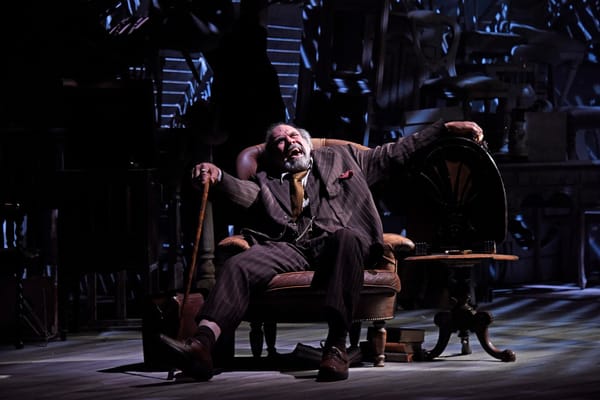Jesus Hopped the ‘A’ Train

Set in the high security wing of Rikers Island, Jesus Hopped the ‘A’ Train boldly contrasts the stories of two inmates and the circumstances that led them there. On one hand, we have new prisoner Angel Cruz, played by Ukweli Roach, who shot a religious cult leader “in the ass” for brainwashing his friend – he’s frightened, confused, and doesn’t really know where he stands or what’s going to happen to him. On the other hand, there’s veteran inmate Lucius Jenkins, played by Oberon K. A. Adjepong, a serial killer who endures life on death row by God-fearing preaching and unreciprocated philosophical discourse with sadistic, no-nonsense guard Valdez. The dialogue goes from sharp and witty to deep debates fluently, and the men argue about forgiveness, faith, redemption, responsibility, and crime. The delivery was spot on, from Adjepong’s powerful performance as almost-too-righteous and aggressively committed to his cause, to Roach as superficially cocky but in reality terrified. There’s also fine work by both Joplin Sibtain and Dervla Kirwan, who play the archetypal callous warden and arrogant defence lawyer respectively. The set itself, expertly designed by Magda Willi, was evocative – a catwalk-type stage running through the middle with seating on either side, and perpendicular sliding glass doors to signify the divisions between jail cells. Young Vic plays are always interestingly staged, but this design lent itself particularly well to the context. Aside from the ‘jail cells’ and a chair, there is nothing else – it is totally bare, with no clutter, both exposing the characters symbolically, and also allowing their emotion and acting to do all the talking, so the audience can really appreciate it. It is interesting to see when the doors move together and apart from each other, they are representing the compression and decompression physically, mirroring the character arcs. The dense writing really thrives here, and as Willi says in an interview, they didn’t need much décor to make it work. The sound design starts off slightly abrasive, with the cacophony of trumpets with lights out during scene changes,but you get used to it. In short, the play is addressing important questions of facing up to your wrongdoings and holding yourself accountable, and whether redemption is ever possible, which I’m sure everyone can relate to (just maybe not on a scale this extreme). There are no easy answers, and whilst you won’t leave the theatre knowing exactly what the message of the play was meant to be, it provides a lot of food for thought – and really, what more could you ask for?
Set in the high security wing of Rikers Island, Jesus Hopped the ‘A’ Train boldly contrasts the stories of two inmates and the circumstances that led them there. On one hand, we have new prisoner Angel Cruz, played by Ukweli Roach, who shot a religious cult leader “in the ass” for brainwashing his friend – he’s frightened, confused, and doesn’t really know where he stands or what’s going to happen to him. On the other hand, there’s veteran inmate Lucius Jenkins, played by Oberon K. A. Adjepong, a serial killer who endures life on death row by God-fearing preaching and unreciprocated philosophical discourse with sadistic, no-nonsense guard Valdez.
The dialogue goes from sharp and witty to deep debates fluently, and the men argue about forgiveness, faith, redemption, responsibility, and crime. The delivery was spot on, from Adjepong’s powerful performance as almost-too-righteous and aggressively committed to his cause, to Roach as superficially cocky but in reality terrified. There’s also fine work by both Joplin Sibtain and Dervla Kirwan, who play the archetypal callous warden and arrogant defence lawyer respectively.
The set itself, expertly designed by Magda Willi, was evocative – a catwalk-type stage running through the middle with seating on either side, and perpendicular sliding glass doors to signify the divisions between jail cells. Young Vic plays are always interestingly staged, but this design lent itself particularly well to the context. Aside from the ‘jail cells’ and a chair, there is nothing else – it is totally bare, with no clutter, both exposing the characters symbolically, and also allowing their emotion and acting to do all the talking, so the audience can really appreciate it. It is interesting to see when the doors move together and apart from each other, they are representing the compression and decompression physically, mirroring the character arcs. The dense writing really thrives here, and as Willi says in an interview, they didn’t need much décor to make it work. The sound design starts off slightly abrasive, with the cacophony of trumpets with lights out during scene changes,but you get used to it.
In short, the play is addressing important questions of facing up to your wrongdoings and holding yourself accountable, and whether redemption is ever possible, which I’m sure everyone can relate to (just maybe not on a scale this extreme). There are no easy answers, and whilst you won’t leave the theatre knowing exactly what the message of the play was meant to be, it provides a lot of food for thought – and really, what more could you ask for?
-4 stars








